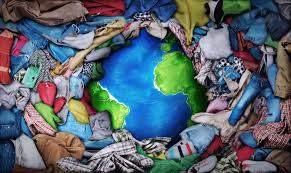The Environmental Impact of Fast Fashion: A Deep Dive 
Fast fashion has revolutionized the clothing industry, offering consumers access to trendy apparel at unprecedented prices. However, this rapid production and consumption model comes at a significant environmental cost. This article explores the various ways fast fashion impacts the environment, examining its contributions to pollution, waste, resource depletion, and climate change. Additionally, we’ll discuss potential solutions and the role of consumers in mitigating these impacts.
Understanding Fast Fashion
What is Fast Fashion?
Fast fashion refers to a business model that focuses on quick turnaround times for producing inexpensive clothing based on the latest trends. Brands like Zara, H&M, and Forever 21 exemplify this model, which prioritizes speed and affordability over sustainability. The goal is to provide consumers with new styles at low prices, encouraging frequent purchases and rapid disposal of clothing.
The Growth of Fast Fashion
The rise of fast fashion can be attributed to several factors:
- Globalization: Advances in technology and transportation have made it easier for brands to source materials and labor from around the world, often seeking the cheapest options.
- Consumer Demand: The increasing desire for trendy, affordable clothing has led to a culture of disposability, where consumers buy more than they need and quickly discard items.
- Marketing and Social Media: The rise of social media has accelerated the spread of fashion trends, with influencers promoting new styles almost daily, fueling the need for constant consumption.
Environmental Impacts of Fast Fashion
- Resource Depletion
Fast fashion’s demand for cheap, trendy clothing requires substantial natural resources:
- Water Consumption: The fashion industry is a major water consumer, with the production of cotton alone requiring approximately 7,500 liters of water to produce just one pair of jeans. This massive water usage contributes to water scarcity in many regions.
- Land Use: Cultivating cotton and other materials often involves large-scale agriculture, leading to deforestation, loss of biodiversity, and habitat destruction. The expansion of land for cotton farming can encroach on natural ecosystems, displacing wildlife.
- Pollution
The fast fashion industry is a significant source of pollution in several forms:
- Water Pollution: Dyeing and finishing processes in textile production often involve harmful chemicals, which can contaminate local water supplies. In countries with lax environmental regulations, wastewater from factories is frequently discharged directly into rivers, harming aquatic ecosystems and communities.
- Air Pollution: The production of synthetic fibers, such as polyester and nylon, emits greenhouse gases and other pollutants into the atmosphere. The processing of these materials often requires fossil fuels, contributing to air pollution and climate change.
- Waste Generation

Fast fashion fosters a throwaway culture that leads to overwhelming amounts of waste:
- Landfill Overload: In the United States alone, approximately 11.3 million tons of textile waste is generated each year. Many of these items are discarded after only a few wears, contributing to the growing landfill crisis.
- Microplastics: Many fast fashion garments are made from synthetic materials that shed microplastics during washing. These microplastics eventually enter waterways, posing a significant threat to marine life and ecosystems.
- Climate Change
The fashion industry is responsible for a considerable portion of global greenhouse gas emissions:
- Carbon Footprint: According to the United Nations, the fashion industry accounts for about 10% of global carbon emissions. This is primarily due to energy-intensive production processes, transportation, and waste disposal.
- Transportation Emissions: Fast fashion relies on global supply chains that require extensive transportation. The shipping of goods across continents increases carbon emissions, contributing to climate change.
Case Studies: Environmental Impacts
- The Water Crisis in Bangladesh
Bangladesh is one of the largest producers of garments for fast fashion brands. The industry has led to severe water depletion in the region, where rivers have dried up, affecting local communities and agriculture. The intense water usage for textile production has also contributed to pollution in waterways, endangering fish populations and human health.
- The Impact of Synthetic Fibers
The use of synthetic fibers, such as polyester, has skyrocketed in fast fashion. Polyester is derived from petroleum, making its production energy-intensive and reliant on fossil fuels. Additionally, garments made from synthetic materials contribute to the microplastics problem, as they shed tiny plastic fibers during washing, ultimately contaminating oceans and harming marine life.
Potential Solutions and Alternatives
- Sustainable Practices
Brands are beginning to adopt more sustainable practices in response to consumer demand for ethical and environmentally friendly products:
- Eco-Friendly Materials: The use of organic cotton, hemp, Tencel™, and recycled materials can significantly reduce the environmental impact of clothing production.
- Waterless Dyeing Technologies: Innovations in dyeing processes, such as waterless dye technologies, can minimize water usage and pollution.
- Circular Fashion

The concept of circular fashion aims to extend the life cycle of clothing through reuse, recycling, and sustainable design:
- Repair and Upcycling: Encouraging consumers to repair and upcycle their garments can reduce waste and prolong the life of clothing.
- Recycling Programs: Brands can implement take-back schemes, allowing consumers to return used garments for recycling or repurposing, thereby minimizing landfill waste.
- Consumer Responsibility
Consumers play a critical role in shaping the future of fashion. By making informed choices, individuals can help drive the demand for ethical and sustainable practices:
- Mindful Purchasing: Consumers can reduce their consumption by purchasing higher-quality items that last longer and by supporting brands that prioritize sustainability.
- Second-Hand Shopping: Thrifting and buying second-hand clothing can help reduce the demand for new garments, thereby minimizing waste and resource depletion.
- Advocacy and Awareness: Educating others about the environmental impact of fast fashion and advocating for sustainable practices can create a ripple effect, promoting change within the industry.
Conclusion
The environmental impact of fast fashion is profound and multifaceted, contributing to resource depletion, pollution, waste generation, and climate change. As consumers and brands become increasingly aware of these issues, there is a growing movement toward more sustainable practices in the fashion industry.
Addressing the environmental challenges posed by fast fashion requires a collaborative effort among brands, consumers, and policymakers. By prioritizing sustainable materials, embracing circular fashion principles, and fostering consumer responsibility, the fashion industry can move towards a more sustainable future. Ultimately, a shift away from the fast fashion model is essential for protecting our planet and ensuring a healthier, more equitable world for future generations.
